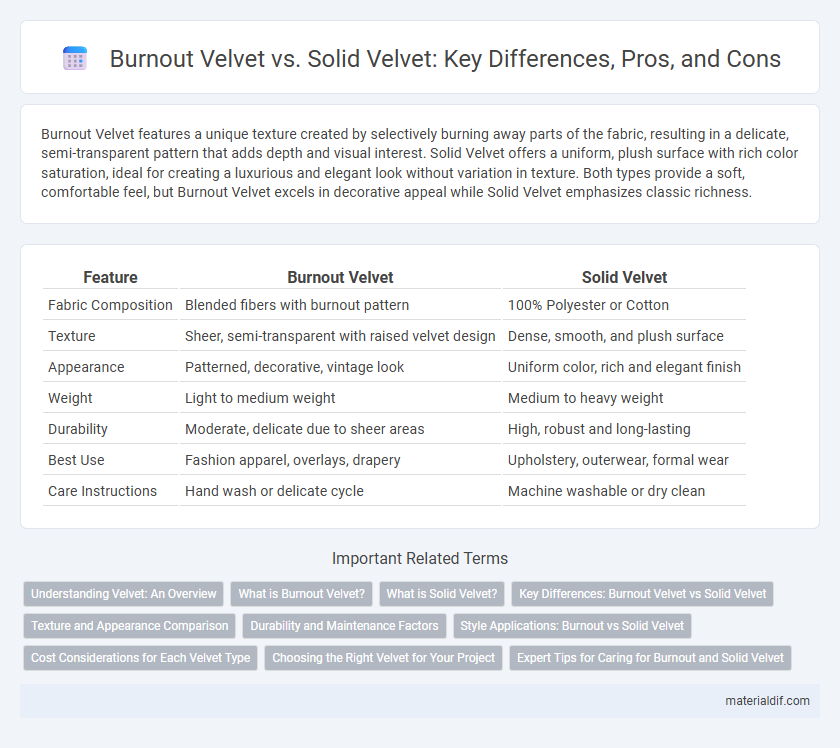Burnout Velvet features a unique texture created by selectively burning away parts of the fabric, resulting in a delicate, semi-transparent pattern that adds depth and visual interest. Solid Velvet offers a uniform, plush surface with rich color saturation, ideal for creating a luxurious and elegant look without variation in texture. Both types provide a soft, comfortable feel, but Burnout Velvet excels in decorative appeal while Solid Velvet emphasizes classic richness.
Table of Comparison
| Feature | Burnout Velvet | Solid Velvet |
|---|---|---|
| Fabric Composition | Blended fibers with burnout pattern | 100% Polyester or Cotton |
| Texture | Sheer, semi-transparent with raised velvet design | Dense, smooth, and plush surface |
| Appearance | Patterned, decorative, vintage look | Uniform color, rich and elegant finish |
| Weight | Light to medium weight | Medium to heavy weight |
| Durability | Moderate, delicate due to sheer areas | High, robust and long-lasting |
| Best Use | Fashion apparel, overlays, drapery | Upholstery, outerwear, formal wear |
| Care Instructions | Hand wash or delicate cycle | Machine washable or dry clean |
Understanding Velvet: An Overview
Burnout velvet features a textured pattern achieved by chemically dissolving parts of the fabric, creating a semi-transparent effect distinct from the uniform appearance of solid velvet. Solid velvet offers a smooth, plush surface with consistent color and texture throughout, making it ideal for luxurious upholstery and clothing. Understanding these differences helps in selecting the appropriate velvet type based on aesthetic preferences and functional needs.
What is Burnout Velvet?
Burnout velvet is a unique fabric characterized by its semi-transparent patterns created through a chemical process that dissolves the fiber in specific areas, resulting in a soft, textured design contrasting with solid velvet's uniform pile. This technique combines plush velvet with sheer sections, offering a luxurious and decorative effect ideal for fashion and upholstery. Burnout velvet's light and airy appearance distinguishes it from the denser, more opaque solid velvet, making it a popular choice for elegant garments and home decor.
What is Solid Velvet?
Solid velvet is a type of fabric characterized by its smooth, dense pile and uniform color throughout the material. Unlike burnout velvet, which has patterns created by burning away parts of the fabric, solid velvet maintains a consistent texture and rich, plush feel ideal for upholstery, drapery, and fashion applications. This fabric is prized for its durability, luxurious appearance, and ability to provide a seamless, elegant finish.
Key Differences: Burnout Velvet vs Solid Velvet
Burnout velvet features a semi-transparent pattern created by chemically dissolving parts of the fabric, resulting in a textured contrast between sheer and plush areas. Solid velvet offers a uniform, dense pile with consistent color and texture throughout the fabric, providing a smooth and luxurious appearance. The key differences between burnout velvet and solid velvet lie in their visual texture, opacity, and the techniques used to produce their distinct designs.
Texture and Appearance Comparison
Burnout velvet features a distinctive semi-transparent pattern created by burning out the fabric's fibers, resulting in a textured contrast between sheer and plush areas that gives a luxurious, multi-dimensional appearance. Solid velvet offers a consistent, dense pile with a smooth, uniform texture that emphasizes rich color depth and a classic, elegant sheen. The interplay of light on burnout velvet enhances its intricate designs, while solid velvet provides a sleek and opulent surface ideal for timeless sophistication.
Durability and Maintenance Factors
Burnout velvet features a unique textured pattern created by chemically burning away portions of the fabric, resulting in a delicate feel that requires gentle care to maintain its appearance and durability. Solid velvet boasts a denser weave, offering enhanced resilience against wear and easier maintenance, making it better suited for high-traffic upholstery and frequent use. Both fabrics require specific cleaning methods, but solid velvet generally withstands daily wear and cleaning more effectively than burnout velvet.
Style Applications: Burnout vs Solid Velvet
Burnout velvet features a sheer, textured pattern created by dissolving fibers, offering a dynamic, semi-transparent look ideal for statement garments and layered designs. Solid velvet provides a rich, uniform pile with a smooth, dense surface perfect for classic, elegant styles and structured apparel. Style applications for burnout velvet emphasize visual interest and depth, while solid velvet focuses on luxurious texture and timeless sophistication.
Cost Considerations for Each Velvet Type
Burnout velvet typically costs more than solid velvet due to its intricate patterning process that combines fabric types to create a semi-transparent design, increasing production complexity. Solid velvet, made from a single type of plush fabric, generally offers a more affordable price point with consistent texture and durability. Budget-conscious buyers often weigh the aesthetic uniqueness of burnout velvet against the cost-efficiency and uniform appearance of solid velvet.
Choosing the Right Velvet for Your Project
Burnout velvet features a semi-transparent pattern created by dissolving fibers, offering a unique texture ideal for decorative projects requiring visual depth and light diffusion. Solid velvet provides a uniform, plush surface with rich, vibrant colors, perfect for upholstery and garments demanding durability and consistent appearance. Selecting between burnout and solid velvet depends on the project's functional needs, desired aesthetic effect, and durability requirements.
Expert Tips for Caring for Burnout and Solid Velvet
Burnout velvet requires gentle cleaning with a vacuum or soft brush to maintain its delicate texture, while solid velvet benefits from regular vacuuming to prevent dust buildup and preserve its rich pile. Use a mild detergent and cold water for spot cleaning both fabrics, avoiding excessive moisture which can damage the fibers and cause irreversible marks. Professional cleaning every 12-18 months extends the life of velvet upholstery, with specific attention to the unique textures of burnout and solid velvet to retain their luxurious appearance.
Burnout Velvet vs Solid Velvet Infographic

 materialdif.com
materialdif.com